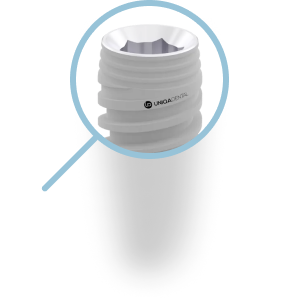Drilling procedure for UNIQA Dental Pure & Porous Implant UH8 UV11 [ 4.2 mm | D4 bone density ]
Video description of the drilling protocol
IMPORTANT: The installation of Uniqa Dental implants is an important and responsible procedure that should only be carried out by a qualified dentist with experience in this field. In this process, a specific protocol for preparing the socket must be followed.
To install a 4.2 mm diameter implant in soft D4 bone, the socket must first be drilled into the hardest cortical layer of the bone using a special drill for cortical bone. Remember that the thickness of the cortical layer in this type of bone is small, usually between 1-1.6 mm. Next, use a 2 mm pilot drill to penetrate the socket to full depth, applying moderate pressure and intense irrigation to cool the drill and bone.
Then, use a sequence of drills with increasing diameter to expand the socket to the required depth. First, drill 2/3 of the depth with a 2.5 mm diameter drill, then expand the socket to the same depth with a 2.8 mm diameter drill, and finally use a 3.2 mm diameter drill to penetrate half the total depth.
Intense irrigation with water should be provided during drilling to avoid overheating the bone and causing thermal necrosis of the bone tissue after implant installation. After each drill pass, thoroughly rinse the socket with isotonic or physiological sodium solution to remove bone debris and reduce the temperature in the bone.
Next, install the implant in the socket. Use the aggressive thread profile of Uniqa Dental implants to screw it directly into the bone tissue and ensure good primary stability. The maximum allowable torque for implant installation is 50 N*cm.
It is important to remember that improper implant installation can lead to various complications, including implant rejection, wound infection, and even damage to surrounding tissues.



![Drilling procedure for UNIQA Dental Pure & Porous Implant UH8 UV11 [ 3.3 mm | D1 bone density ]](https://img.youtube.com/vi/lNch2ns-gAI/maxresdefault.jpg)




